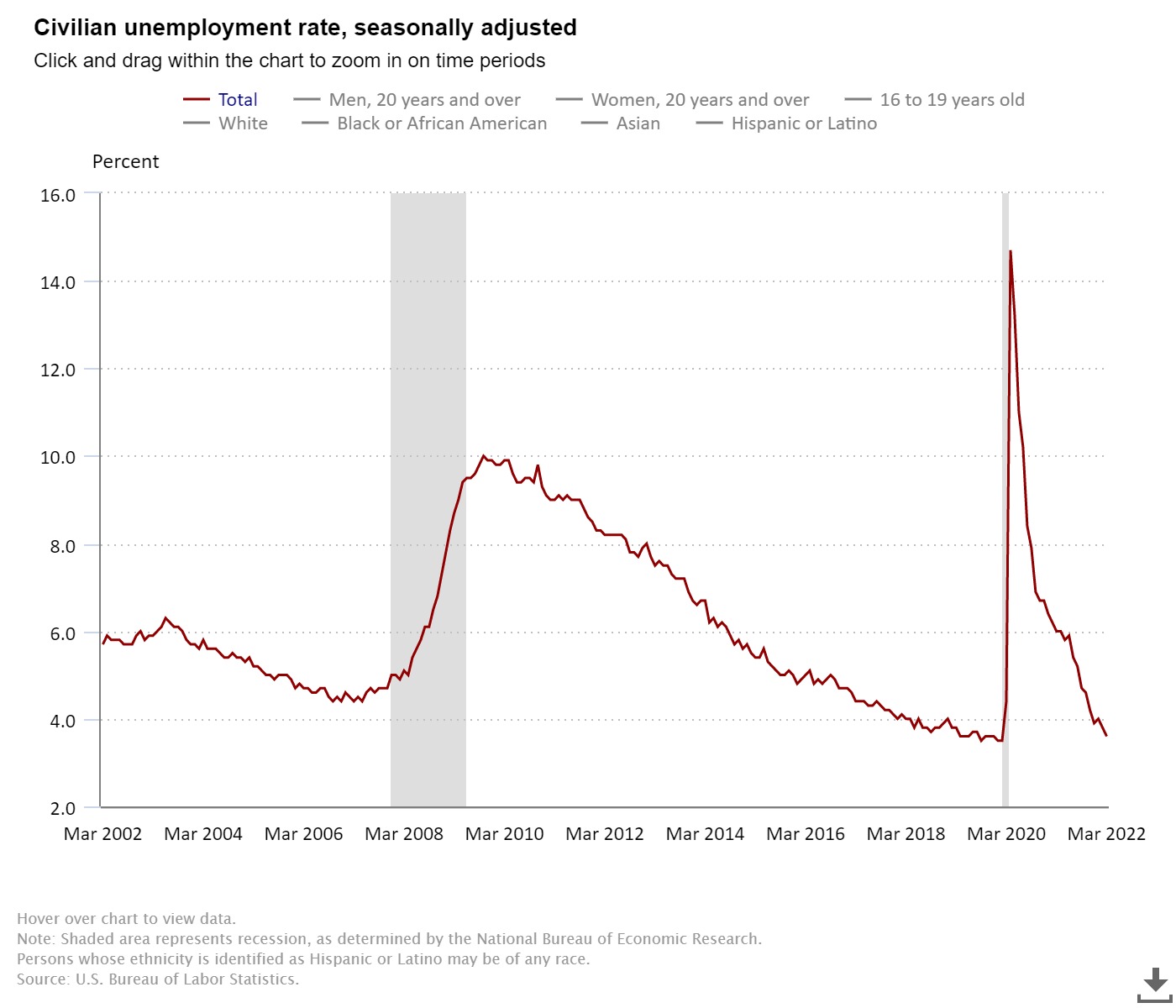Washington, DC…Total nonfarm payroll employment rose by 431,000 in March, and the unemployment rate declined to 3.6 percent, the U.S. Bureau of Labor Statistics reported today. Notable job gains continued in leisure and hospitality, professional and business services, retail trade, and manufacturing.
This news release presents statistics from two monthly surveys. The household survey measures labor force status, including unemployment, by demographic characteristics. The establishment survey measures nonfarm employment, hours, and earnings by industry. For more information about the concepts and statistical methodology used in these two surveys, see the Technical Note.
Household Survey Data
The unemployment rate declined by 0.2 percentage point to 3.6 percent in March, and the number of unemployed persons decreased by 318,000 to 6.0 million. These measures are little different from their values in February 2020 (3.5 percent and 5.7 million, respectively), prior to the coronavirus (COVID-19) pandemic. (See table A-1.)
Among the major worker groups, the unemployment rate for adult women (3.3 percent) declined in March. The jobless rates for adult men (3.4 percent), teenagers (10.0 percent), Whites (3.2 percent), Blacks (6.2 percent), Asians (2.8 percent), and Hispanics (4.2 percent) showed little change over the month. (See tables A-1, A-2, and A-3.)
Among the unemployed, the number of permanent job losers decreased by 191,000 to 1.4 million in March and is little different from its February 2020 level of 1.3 million. The number of persons on temporary layoff was little changed over the month at 787,000 and has essentially returned to its February 2020 level. The number of job leavers–that is, unemployed persons who quit or voluntarily left their previous job and began looking for new employment–fell by 176,000 to 787,000 in March. (See table A-11.)
In March, the number of long-term unemployed (those jobless for 27 weeks or more) decreased by 274,000 to 1.4 million. This measure is 307,000 higher than in February 2020. The long-term unemployed accounted for 23.9 percent of all unemployed persons in March. (See table A-12.)
The labor force participation rate, at 62.4 percent, changed little in March. The employment-population ratio increased by 0.2 percentage point to 60.1 percent. Both measures remain below their February 2020 values (63.4 percent and 61.2 percent, respectively). (See table A-1.)
The number of persons employed part time for economic reasons was about unchanged at 4.2 million in March and is little different from its February 2020 level. These individuals, who would have preferred full-time employment, were working part time because their hours had been reduced or they were unable to find full-time jobs. (See table A-8.)
The number of persons not in the labor force who currently want a job increased by 382,000 to 5.7 million in March, following a decrease of a similar magnitude in the prior month. This measure is above its February 2020 level of 5.0 million. These individuals were not counted as unemployed because they were not actively looking for work during the 4 weeks preceding the survey or were unavailable to take a job. (See table A-1.)
Among those not in the labor force who wanted a job, the number of persons marginally attached to the labor force, at 1.4 million, changed little in March. These individuals wanted and were available for work and had looked for a job sometime in the prior 12 months but had not looked for work in the 4 weeks preceding the survey. The number of discouraged workers, a subset of the marginally attached who believed that no jobs were available for them, was essentially unchanged over the month at 373,000. (See Summary table A.)
Household Survey Supplemental Data
In March, 10.0 percent of employed persons teleworked because of the coronavirus pandemic, down from 13.0 percent in the prior month. These data refer to employed persons who teleworked or worked at home for pay at some point in the 4 weeks preceding the survey specifically because of the pandemic.
In March, 2.5 million persons reported that they had been unable to work because their employer closed or lost business due to the pandemic–that is, they did not work at all or worked fewer hours at some point in the 4 weeks preceding the survey due to the pandemic. This measure is down from 4.2 million in the previous month.
Among those who reported in March that they were unable to work because of pandemic-related closures or lost business, 15.4 percent received at least some pay from their employer for the hours not worked, down from 20.3 percent in February.
Among those not in the labor force in March, 874,000 persons were prevented from looking for work due to the pandemic, down from 1.2 million in the prior month. (To be counted as unemployed, by definition, individuals must be either actively looking for work or on temporary layoff.) These supplemental data come from questions added to the household survey beginning in May 2020 to help gauge the effects of the pandemic on the labor market. The data are not seasonally adjusted. Tables with estimates from the supplemental questions for all months are available online at www.bls.gov/cps/effects-of-the-coronavirus-covid-19-pandemic.htm.
Establishment Survey Data
Total nonfarm payroll employment rose by 431,000 in March, as job gains continued in leisure and hospitality, professional and business services, retail trade, and manufacturing. Overall, job growth averaged 562,000 per month in the first quarter of 2022, the same as the average monthly gain for 2021. However, employment is down by 1.6 million, or 1.0 percent, from its pre-pandemic level in February 2020. (See table B-1.)
Employment in leisure and hospitality continued to increase, with a gain of 112,000 in March. Job growth occurred in food services and drinking places (+61,000) and accommodation (+25,000). Employment in leisure and hospitality is down by 1.5 million, or 8.7 percent, since February 2020. Job growth continued in professional and business services, which added 102,000 jobs in March. Within the industry, job gains occurred in services to buildings and dwellings (+22,000), accounting and bookkeeping services (+18,000), management and technical consulting services (+15,000), computer systems design and related services (+12,000), and scientific research and development services (+5,000). Employment in professional and business services is 723,000 higher than in February 2020.
Employment in retail trade increased by 49,000 in March, with gains in general merchandise stores (+20,000) and food and beverage stores (+18,000). Health and personal care stores lost 5,000 jobs. Retail trade employment is 278,000 above its level in February 2020. Manufacturing added 38,000 jobs in March. Employment in durable goods industries rose by 22,000, with gains in transportation equipment (+11,000) and electrical equipment and appliances (+4,000). These gains were partially offset by a loss of 5,000 jobs in nonmetallic mineral products. Nondurable goods manufacturing added 16,000 jobs over the month, including a gain in chemicals (+7,000).
Since February 2020, manufacturing employment is down by 128,000, or 1.0 percent. Employment in social assistance increased by 25,000 in March, with the gain concentrated in individual and family services (+18,000). Employment in social assistance is down by 126,000, or 2.9 percent, from its level in February 2020. Employment in construction continued to trend up in March (+19,000) and has returned to its February 2020 level. In March, employment in financial activities rose by 16,000, with gains in real estate and rental and leasing (+14,000) and in securities, commodity contracts, and investments (+5,000).
Employment in financial activities is 41,000 above its level in February 2020. Health care employment changed little in March (+8,000), after a large increase in the prior month. Employment in the industry is down by 298,000, or 1.8 percent, since February 2020. Employment in transportation and warehousing was essentially unchanged in March (-1,000), following large gains in the prior 2 months. In March, a job gain in couriers and messengers (+7,000) was offset by small losses in other component industries. Employment in transportation and warehousing is 608,000 higher than in February 2020. Employment showed little change over the month in mining, wholesale trade, information, other services, and government. Average hourly earnings for all employees on private nonfarm payrolls rose by 13 cents to $31.73 in March.
Over the past 12 months, average hourly earnings have increased by 5.6 percent. In March, average hourly earnings of private sector production and nonsupervisory employees rose by 11 cents to $27.06. (See tables B-3 and B-8.) The average workweek for all employees on private nonfarm payrolls fell by 0.1 hour to 34.6 hours in March. In manufacturing, the average workweek for all employees was unchanged at 40.7 hours, and overtime fell by 0.1 hour to 3.4 hours. The average workweek for production and nonsupervisory employees on private nonfarm payrolls declined by 0.1 hour to 34.1 hours. (See tables B-2 and B-7.)
The change in total nonfarm payroll employment for January was revised up by 23,000, from +481,000 to +504,000, and the change for February was revised up by 72,000, from +678,000 to +750,000. With these revisions, employment in January and February combined is 95,000 higher than previously reported. (Monthly revisions result from additional reports received from businesses and government agencies since the last published estimates and from the recalculation of seasonal factors.) _____________
The Employment Situation for April is scheduled to be released on Friday, May 6, 2022, at 8:30 a.m. (ET).
Employment Situation Summary Table A. Household data, seasonally adjusted
Employment Situation Summary Table B. Establishment data, seasonally adjusted
Employment Situation Frequently Asked Questions
Employment Situation Technical Note
Table A-1. Employment status of the civilian population by sex and age
Table A-2. Employment status of the civilian population by race, sex, and age
Table A-3. Employment status of the Hispanic or Latino population by sex and age
Table A-4. Employment status of the civilian population 25 years and over by educational attainment
Table A-7. Employment status of the civilian population by nativity and sex, not seasonally adjusted
Table A-8. Employed persons by class of worker and part-time status
Table A-9. Selected employment indicators
Table A-10. Selected unemployment indicators, seasonally adjusted
Table A-11. Unemployed persons by reason for unemployment
Table A-12. Unemployed persons by duration of unemployment
Table A-13. Employed and unemployed persons by occupation, not seasonally adjusted
Table A-14. Unemployed persons by industry and class of worker, not seasonally adjusted
Table A-15. Alternative measures of labor underutilization
Table A-16. Persons not in the labor force and multiple jobholders by sex, not seasonally adjusted
Table B-1. Employees on nonfarm payrolls by industry sector and selected industry detail
Table B-5. Employment of women on nonfarm payrolls by industry sector, seasonally adjusted
Access to historical data for the “A” tables of the Employment Situation News Release
Access to historical data for the “B” tables of the Employment Situation News Release



